Muscle cars, by tradition, are supposed to have big V8s as their centerpiece attraction. But what happens when a four cylinder makes as much (or even more) power than most muscle car V8s used to?
You go faster – and get much better gas mileage.
That’s the 2018 Chevy turbo Camaro.
The Camaro is GM’s iconic muscle car.
It’s still available with a muscle car V8 – if you prefer. And a very powerful V6, too. But if you want V8 power and performance without the gas bills – or the higher sticker price and the insurance surcharges – you might want to have a look at the standard Camaro coupe.
It comes with a 275 hp turbocharged four cylinder engine.
Just for reference, that’s more horsepower than most V8 Z28s of the ‘80s and well into the ‘90s – out of an engine with half as many cylinders, that uses only a little less gas than most current economy cars.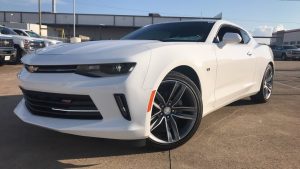
Base price is $26,900 – vs. $37,995 for the V8-powered SS version.
Camaro’s most direct rival is – as always – the Ford Mustang, which also offers a very potent turbocharged four cylinder engine as standard equipment. The Ford’s base price is a bit less – $25,585 to start – and it’s a bit more practical as far as back seat room and trunk space.
There’s also the Dodge Challenger – which is a much larger car than both the Camaro and the Mustang, with usable back seats and a Goodfellas-sized trunk.
It stickers for $26,995 to start.
Chevy – like many – is trying to encourage people to buy by offering lower-priced, less “loaded” versions of its cars. In the case of Camaro, that means a new 1LS trim – but it doesn’t mean you’re getting a stripped-down shell, as it did mean back in the classic muscle car era of the ‘60s and ‘70s.
The 1LS coupe comes with 18 inch aluminum wheels – bigger wheels than any classic-era V8 muscle car ever came with from the factory – a 7 inch LCD touchscreen with WiFi, a six-speaker stereo, power windows, locks, keyless entry, power driver’s seat, adjustable drive modes and – of course – air conditioning.
Even a limited-slip rear axle is included.
The days of the bare-bones muscle car are long gone.
V8 muscle car power – and quickness – with economy car fuel-sippyness.
Less weight up front vs. the V8.
New lower price, without roughing it.
Dodge the insurance mafia.
WHAT’S NOT SO GOOD
Low roofline looks great, but gimps visibility.
Almost-unusable back seat – even for a muscle car.
Ridiculously tiny trunk – even for a muscle car.
The 2018 Camaro comes standard with a 2.0 liter four cylinder engine. Which isn’t the first time Chevy has offered a four cylinder engine in a Camaro. The last time was back in the ‘80s. The difference today is that the 2018 Camaro’s standard four is turbocharged and while it’s economical it is also powerful.
It makes nearly three times the horsepower (275 hp) of the ’80s-era Camaro’s larger (2.5 liter) four – which barely made 100 horsepower – and 100-plus more horsepower than the same-era Camaro Z28’s more-than-twice-its-size 5.0 liter V8 engine, which only made 145 hp, if you can imagine that.
A six-speed manual transmission is standard; an eight-speed automatic is optional.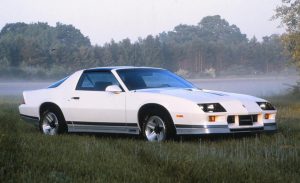
Either way, the turbo Camaro gets to 60 in about 6 seconds flat – quicker than all but small handful of classic-era V8 muscle cars. Quicker – I’m embarrassed to admit – than my gaudy ’76 Trans-Am, which has a 7.4 liter V8 and was – in its day – the strongest and quickest V8 muscle car available.
It got to 60 in about 7 seconds – right there with a new Camry.
And did not get 20 MPG in city driving and 30 on the highway, as the turbo Camaro does. 22 in city driving and 31 on the highway with the optional eight-speed automatic, which is more efficient due to its extra-tall overdrive gearing.
A limited slip differential is standard, either way – as well as selectable drive modes.
This is a big car, even though it’s a two-door. At 188.3 inches long overall, it’s more than a foot longer than sports cars like the Nissan 370Z and Mazda Miata. This is traditional – as muscle cars were never small cars.
It’s a weird feeling, if you’re not used to driving a big car that is also a sporty car. Camaro uses most of its lane, with little margin to either side. But this is ok, because the car’s ability to keep on track is as good – or better – than smaller, sportier cars.
It’s like a 300 pound NFL lineman who can also run.
Speaking of which. The turbo four’s power/performance would have qualified for supercar status back in the ‘80s – and well into the ‘90s. It only pales – in perception – when compared with the ludicrously powerful V8 in the Camaro SS (6.2 liters, 455 hp and 0-60 in 3.9 seconds). Truthfully, the V8 is so powerful that making full use of it requires a combination of luck – that you don’t get caught – using it – as well as room and skill to make full use of it.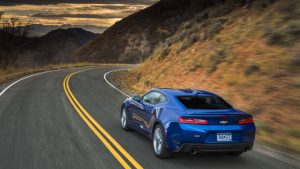
The four, on the other hand, you can make full use of – which is what makes it fun. This means full throttle runs to redline, then stabbing the clutch as you simultaneously grab the next gear up, the tail of the car jiggling left-right just slightly as the tires briefly break – and then regain – traction.
Also, because there is less weight on the nose (vs. the big V8) the four cylinder Camaro reacts to steering inputs with more verve – and feels lighter.
Because, of course, it is.
Another thing to know is that the four is fine with the optional automatic. Back in the day – of the ’80s-era four cylinder Camaro – it wasn’t.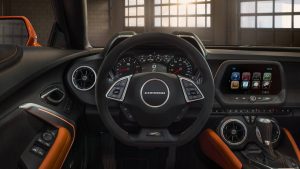
The reason for the difference isn’t displacement; it’s that the current Camaro four is turbocharged – and the turbo effectively inflates the 2.0 liter engine to the functional displacement of a V8 more than twice its size, by producing 295 ft.-lbs. of torque at 3,000 RPM. Torque – plenty of it and as soon as possible – is imperative in big, heavy car with an automatic.
Because without it, the automatic hasn’t got much to work with.
The ’80s-era Camaro’s four barely made torque in the three digits – and so was especially awful when paired with the optional automatic transmission. Slow with the manual transmission, it was paralytic with the automatic. 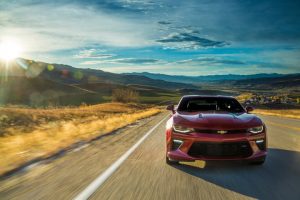
Today, you can go either way – with no performance penalty at all.
There is, however, another penalty – of a different species: Visibility. This the ’80s era Camaro had in abundance, a function of its enormous canopy of glass – most especially the all-glass hatchback but also the large windshield and side glass.
The current Camaro is almost Batmobile-like, with short side glass and a small, almost flat rear window. Unless you are very tall, you will sit very low in the car – and while the view ahead is okay, the view to the rear and to the sides is about the same as Bruce Wayne had inside his car.
Muscle cars are exaggerated cars, the Hulk Hogans of the car world. Bigger – brasher – than the rest. They part the crowd.
The new Camaro definitely does that.
It has some retro-themed styling elements, intended to evoke the first generation ’67-69 Camaro – especially up front – but there is also a infusion of current Corvette themes – especially as viewed from the rear.
Another Corvette commonality is the two seater interior.
Well, technically the Camaro still has four seats – but they are vestigial. The Chevy has the least legroom of any of the three current muscle cars (the others being the Ford Mustang and the Dodge Challenger). There’s 43.9 inches up front – more than many mid-sized sedans have. But the back seat stat is so minimal – about 26 inches – GM doesn’t even publish it.
Combine that with the Camaro’s sexy-looking, low-cut roofline and the result is back seats for gym bags and groceries, not living things.
Well, not bipedal living things.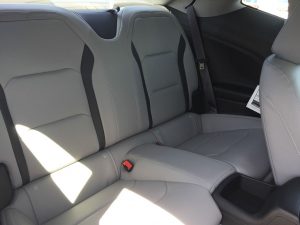
The trunk is also exceptionally small – even for a muscle car: 9.1 cubic feet. The Mustang’s is 13.5 cubic feet; the Challenger – which is a much larger car than either the Chevy or the Ford – has the most usable back seats of the bunch and a full-size sedan-sized 16.2 cubic foot trunk.
But these are practical criteria – and judging a muscle car by them is like judging a beauty pageant by something other than beauty. Like whether the chick on stage can explain NAFTA.
Who cares?
Where it counts, Camaro delivers. It’s showy and brash, an automotive Zoot suit big-stepping it down the street. It leers – and it rumbles. The right people – safety nags, Peak Oil and Climate Change neurotics – annoyed by the very sight of one. Men invariably like them and good-looking women usually do. As far as the ugly ones . . .
Who cares?
As it should be.
The materials inside are less nice than in the Mustang – but nicer than in the Challenger, which is the oldest car of the bunch and the one most in need of updating. And the criticism of the Camaro’s swath of gray/black plastics is – again – a small matter in context of the turbo Camaro’s price. Bitching is appropriate as far the V8 SS, because of its price.
At almost $40k, you’ve got reason ti be slightly disappointed by anything less than Lexus-ish/BMW-near materials and feels. But at $26k-ish – the turbo’s base price – all is copacetic.
One thing GM might have done but didn’t is to give the turbo a unique gauge package, or at least offer one for a few bucks more. The turbo four’s powerband is different, so a different tach face and yellow/redline would be cool. Even more cool would be turbo-specific enhancements such as a power bulge off to one side of the hood – and maybe an adjustable wastegate from the factory.
Mullet in the glovebox optional.
THE REST
Aside from the V8 power and performance – and the lower MSRP and gas bills – there is another good reason to consider the turbo four Camaro: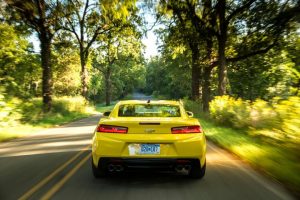
Lower insurance costs.
Especially if you are a young (under 35) single. Insuring a muscle car has always been a killer for the young and single – but you’ll get a break by skipping the V8, because the four is considered less obstreperous by the actuaries.
Despite delivering more power – and better performance – than most of the V8s available in Camaros through the years.
THE BOTTOM LINE
It’s not often you actually can have your cake and eat it, too.
This time, you can.
. . .
Got a question about cars – or anything else? Click on the “ask Eric” link and send ’em in!
If you like what you’ve found here, please consider supporting EPautos.
We depend on you to keep the wheels turning!
Our donate button is here.
If you prefer not to use PayPal, our mailing address is:
EPautos
721 Hummingbird Lane SE
Copper Hill, VA 24079
PS: EPautos magnets – they’re back! are free to those who send in $20 or more to support the site. Also, the eBook – free! – is available. Click here. Just enter you email in the box on the top of the main page and we’ll email you a copy instantly!


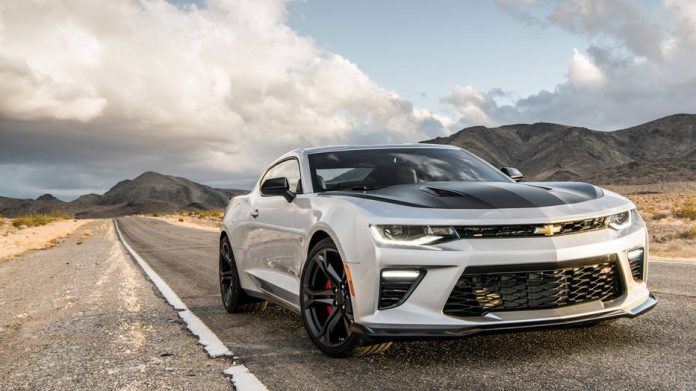

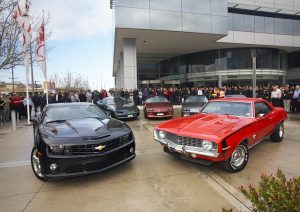
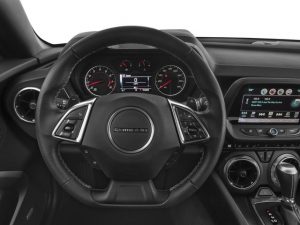



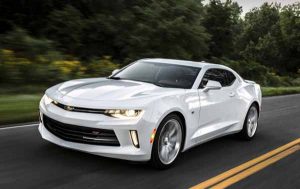







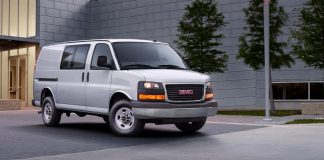
as much as I hate to admit it, the camaro 2.oT is a great car for what it is. I even considered buying one in my search for a RWD car. I just really needed the rear seat and 4-doors for my current needs.
And I recently owned a ATS 2.0T RWD with stick, which BTW is the same chassis the Camaro uses.
At the end of the day, the ATS is/was a great car, and the Camaro is awesome too. My needs just changed to needing a long-haul highway cruiser and the ATS/Camaro is not. The Camaro came off my list also because the ATS/Camaro chassis is just too narrow for me, and while it puts you in a performance position, it is not well liked (for me) driving 6hrs at a clip.
The 300 won the day for me, and the V8 RWD is, yes IS, still much better than the 2.0T, cause I grin when I drive it. And while the 2.0T was pretty quick and I liked it, no comparison to the Hemi with 8sp. It rocks from 0 to 100mph, and passing it is an animal.
IF the Camaro were wider, it would have made my short list.
Hi Chris,
I respect the Camaro and like the Mustang… but I love the Challenger. It is the most faithful to the muscle car concept of the bunch. It’s a big, brutal car. You can carry two bodies in the trunk. And the R/T 6.2 Hemi is my kind of freak. Even with all the saaaaaaafety garbage, you can drive this car sideways anytime you like; just drop the hammer.
I would buy one this afternoon if the divorce hadn’t clipped my wings to the bone!
IMHO the Mustang beats the Camaro hollow when it comes to looks, visibility and practicality. Haven’t driven either one, so will defer to your judgement on that front.
Hi Escher,
I prefer the Mustang as well. But I’d much rather have a Challenger!
I too get a kick out of your comparisons to 1970s era muscle cars and how today’s grocery getter can blow the doors off factory stock vehicles of old. But I wonder what a luxury vehicle of that day compares to a modern vehicle. After all, the Cadillac Sedan DeVille had an option for a 500 cubic inch engine, and according to the Book Of Knowledge: “a showroom-stock 1971 Coupe de Ville placed third in the annual coast-to-coast Cannonball Run, posting the highest average speed of the event, 84.6 mph (136.2 km/h) (excluding stops) and averaging 8.9 mpg‑US (26 L/100 km; 10.7 mpg‑imp).”
Sounds like if it didn’t have the “boulevard ride” suspension it might have been in good company with the straight six powered Europeans of the day.
It makes you wonder why GM designers chose to style the new one after the 1967 instead of the sexy, sleek 1970 model. That’s when the Camaro became its own man, IMO.
Hi Handler,
I agree! The ’70-81 F cars were the best looking. Styled to emulate early-mid ’60s Ferraris – and well-done. Even my ’76 Trans-Am (Camaro’s fraternal twin) looks great, despite the nose clip changes needed to appease Uncle’s first round of saaaaaaaaaaaaaaaafety mandates!
eric, it’s the disdainful catfish….sneering at the competition. I agree the 70 would be a much better car to emulate…..but why stop there? Hell, just take a cue from an old Ferrari GTO and go with it. I was sick of catfish styling by the 3rd car I saw with it. Sad, mad, happy, hopeful…..all those catfish models…..
“20 MPG in city driving and 30 on the highway, as the turbo Camaro does. 22 in city driving and 31 on the highway with the optional eight-speed automatic”
I’m gonna guess that the price to upgrade to the 8 speed won’t ever be less than the miniscule gas savings. Is the 8 speed tranny quicker due to better gear ratios for getting off the line quick?
Looks like 1st gear would be near unusable without traction control or slicks on a prepped surface (assuming the 8l45 trans and 3.27 final drive with the 20″ wheel/tire package). Thing has an SLR of 15.11 ( http://www.wallaceracing.com/calc-slr.php ), given traction it should jump off the line pretty well, otherwise it is just a burnout machine. The close gear spread of the 8 speed should allow it to pull nicely up top vs the older 3 and 4 speed autos that have a big jump between gears (usually they lay down a bit once shifted into 3rd which would be the equivalent of 6th gear in the 8 speed). Gears 7 & 8 are both overdrives (fuel economy), top speed runs would be done in 6th.
Thanks for the honesty regarding old “muscle cars” vs. the new. The old provide attractive designs and “nostalgia” but not outstanding performance or mileage.
At a recent car show I attended I mentioned new vs. old and the old muscle car owner wasn’t happy and didn’t accept reality.
I have mixed feelings when, on the highway, passing old slow moving “muscle cars” in my better performing, better geared, modern performance vehicle. Maybe the old is for show and the new for go.
Hi Liberty,
Yup!
Much as I love the old stuff – style, more character – it is also ’50s-era technology and not capable of making the kind of easy/everyday/reliable/daily driver power that modern cars boats without benefit of retro-fitting modern tech, such as alloy heads, roller cams and so on.
On the other hand, the old stuff is relatively light compared with the new stuff – and it’s petty easy (and cheap) to make something like my ’76 TA more than quick enough to be lots of fun. Mine won’t beat a new ZL1 Camaro… but a low 13 second quarter on 15×7 tires, without traction/stability control feels hairier!
I’m questioning the “muscle-car-iness” of the turbo 4 Camaro. 0-60 in 6 seconds is about half a second quicker than my 11 year old Toyota, which has a huge back seat and a large trunk.
I mean, the Camaro’s got great styling, but aren’t muscle cars supposed to be fast compared to family sedans?
Just guessing here, but I think the Camaro would easily walk away from your Camry above 60 mph
It would slowly pull ahead around 60 MPH. I’ve got an Avalon with a 268 HP V6 — the Camaro has nearly the same HP, but is lighter and has less aerodynamic drag. It would pull ahead faster and faster as the speed went up, due to aerodynamic drag going up as the cube of speed, but at 60 MPH that isn’t the overriding factor consuming HP.
Not that I have anywhere in Texas where I would want to go 100 MPH — lots of 80 MPH roads here, but 100 MPH is asking for payin paper, and would be unnervingly fast for my skill level.
FWIW 0.5 second difference to 60mph is at least a solid car length. It’s not like you would be side by side….
You ever seen the difference between an 11 sec. car and a 14 sec. car from the vantage point of the slower vehicle? You might think you were keeping up but you weren’t.
Hi Dirty,
There’s also the intangible of the manual to consider. It is becoming hard to find a stickshift sedan. Camaro’s also rear-drive and when you combine that with a manual, the result is a kind of fun that a FWD/automatic sedan can’t match.
Hi Jim,
It’s a solid objection; of course, 0-60 in 6 is still pretty quick, regardless!
Eric,
Off topic and you’ve probably already seen it, but, another Tesla “autopilot” crash:
Tesla Model S On Autopilot Rams Into Parked Fire Truck On Freeway
http://www.ibtimes.com/g00/tesla-model-s-autopilot-rams-parked-fire-truck-freeway-2644087?i10c.encReferrer=aHR0cDovL3d3dy5yb25wYXVsZm9ydW1zLmNvbS9zaG93dGhyZWFkLnBocD81MTg3MjAtVGVzbGEtTW9kZWwtUy1Pbi1BdXRvcGlsb3QtUmFtcy1JbnRvLVBhcmtlZC1GaXJlLVRydWNrLU9uLUZyZWV3YXkmcD02NTc4OTk1&i10c.ua=1
Hi AHF,
Yup – I may rant about this… “auto-crash” is more like it, eh?
Haha! Did you see the note that said Tesla is aiding in the investigation? What a crock of shit. They just want to find out what to conceal first, in order to indemnify themselves from any liability. The Next model should be called the “Blind-Bat”. How many times does their shit need to crash and burn before Tesla Corp. does the same??? I don’t recall anyone lining up on waiting lists to buy a Pinto when it started “crashing and burning”!
People really have to be shit-wit brainless to fall for this suicidal Auto-Drive crap! Just more proof that money does NOT equal brains!
Nice to see you are not on Government Motor’s shit list anymore.
I am… they just didn’t know about this… don’t ask, don’t tell!
So does this mean you’re no longer double plus ungood in the eyes of the general, or is this a pirate review?
Does it pipe in engine noises as well?
Hi Brazos,
No – but I wish you could hear the turbo whistle…
Nah, they probably will ban that too. Sounds to “masculine” to fit into their image of “diversity”. A turbo-4 in a Camaro seems a bit “gay” to me……that should really appeal to their diversity culture crap! Why don’t they supercharge these things? Better performance and less repair cost. I don’t recall one complaint about the late model supercharged FWD Police Impala, let alone the hundreds of supercharged Buick FWD Regal 3.8’s.